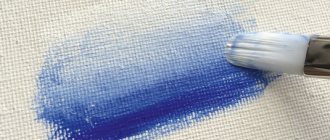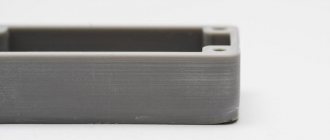Which acrylic paints are best for painting: TOP brands
Nylon and synthetic brushes are suitable for acrylic.
I think that after such a detailed article you will no longer have any questions about acrylic and you can go to the store with peace of mind and buy everything you need to start creating your masterpieces very soon!
And here, in fact, are my TOP 6 artistic acrylic paints for painting:
- Expensive foreign paint “Winsor&Newton”
- French paint "PEBEO"
- Domestic paint and the familiar Master Class brand
- The same – artistic acrylic paints “Sonnet”
- “Acrylic-Art”, from the St. Petersburg brand “Tair”
- “Vista-Artista” paints, also known as “Gamma”
All these colors are good in their own way. When choosing any of them, you definitely can’t go wrong with either quality or price. Of course, some of them will be more expensive, some will be cheaper, but no matter what you choose, you will be able to paint a picture with any of them.
If you want a paint that is not expensive compared to foreign acrylic paints, but of good quality compared to Russian analogues, take it.
These are the best acrylic paints for students and professionals.
Why prime a painting?
Priming the surface helps improve the adhesion of materials to each other. Obtain the required texture and background for further paint application. For acrylic paints, you can skip this step.
Priming the surface helps improve the adhesion of materials to each other.
Types of soils
There are several types of primer mixtures suitable for working with canvas. They have different properties, knowledge of which will help you choose the right option for a particular task. Highlight:
- Glue is used for oil paints; products dry on it faster and do not crack;
- Emulsion does not dissolve in water, suitable for all types of canvases. Can be used with any paints;
- Oil paint is intended for paints of the same name, but the drying stage will take at least 12 months;
- Acrylic is suitable for oil, acrylic and tempera paints and can be applied to different canvases.
There are several types of primer mixtures suitable for working with canvas.
Basic properties of acrylic paints
Acrylic is a fairly modern paint. Compared to tempera or oil paints, acrylic paints appeared relatively recently, in the middle of the twentieth century! But despite this, many artists have already managed to study it thoroughly and began to paint their masterpieces with artistic acrylic paints!
But first things first. For now, let's look at the basic properties of acrylic paints. Why and why do modern artists love them so much?
Acrylic is a paint made up of water, pigment and acrylic resin. It is suitable for any surface : canvas, wood, glass, ceramics, fabric, metal, concrete and brick, wallpaper, cardboard and many others. Agree, quite a large scope compared to other paints!
Acrylic is a universal paint!
In addition to their wide range of applications, acrylic paints have a number of environmentally beneficial properties for humans! Firstly, they do not have such a strong odor as oil paints. Water-based acrylic paint for painting has virtually no odor , which makes it ideal for painting walls, for example, or working on a large canvas.
This paint can also be safely used in public places, for example, at large master classes, when working with children and allergy sufferers. A rich color palette is another advantage and very important property of acrylic! With such a huge selection of colors and shades, you have almost limitless possibilities - you can create your own unique masterpiece, embody the most interesting and bright ideas!
Acrylic paints have a real riot of color!
Important clarification: if you plan to apply paint in several layers, take more expensive brands. Cheap and low-quality acrylic will of course cover up the colors, but you will have to apply much more layers than you planned.
Another nice property of acrylic paints is how quickly they dry. You don't have to wait several days for the next layer of paint to dry, as is the case with oil painting. Acrylic will dry in a couple of hours, and completely in 4-5 hours.
This is an advantage when, for example, you are painting a painting to order and the deadline for delivery of the work is important to you. But there is a downside, acrylic dries quickly not only on canvas, but also on brushes, hands and any other surfaces with which you worked.
Therefore, in order not to fiddle with your brushes for a long time, you just need to immediately rinse them with water and the paint will be washed off. Thinners and special cleaners are not needed, since acrylic dissolves very well in water .
But despite this property, dried acrylic paint, on the contrary, will be resistant to water. By the way, environmental resistance is another useful property of acrylic. These paints are not only not afraid of water, but also withstand temperature changes, humidity, sunlight and other factors.
Of course, sometimes it happens that acrylic paint cracks or fades. But this is most likely due to the fact that the paint was originally cheap and of poor quality. Or it was already approaching its expiration date.
Acrylic can be sold both in sets and in individual tubes! Just like butter!
This is why I always advise my students to test paint and other painting materials before purchasing. And it’s better to immediately purchase everything you need in my online store. After all, there I personally select all the materials and use them in my courses.
So, let's now summarize the main properties of acrylic paints:
- Suitable for any surfaces;
- Virtually odorless;
- Huge selection of color palettes;
- Dissolves well in water;
- Resistant to external irritants (moisture, sunlight, temperature changes).
Choosing paint for painting on canvas
Previously, to create durable works, artists could only choose oil paints that could last for centuries. Modern technologies have made it possible to develop a new type of paint using acrylic as a base.
Acrylic paints are loved by many creators for their variety of colors and ease of use. They are often used to create modern styles of painting - abstractions or posters. The choice is made based on the preferences of the artist himself and the task at hand: what effect they want to achieve in the end.
You can use both compositions on the same painting; there is no prohibition on using oil and acrylic compositions together.
Acrylic paints are loved by many creators for their variety of colors and ease of use.
Acrylic paints
This type is distinguished by the fact that water is used as a base. If the paint needs to be diluted, then water is added, and after drying, a moisture-resistant coating is created. For this reason, the picture will be stored for a long time without changes. However, the drying process causes the colors to darken, which should be taken into account when using.
Artists note other advantages:
- Drying takes little time;
- No cracks appear on the canvas;
- There is no need to apply varnishes or other means on top for a fixing effect;
- Versatility of use, you can work on wood, metal, glass and canvas.
In paintings by numbers, acrylic compositions are used.
The drying process causes the colors to darken, which should be taken into account when using.
Oil paints
The oil type includes vegetable oils as a component, which helps to form a film-like protection against water on the surface after drying. It was this type that was used to create masterpieces of painting. Once the layer has dried onto the surface, it does not change tone.
The standard base for artistic paints is linseed oil. To successfully work with this type, you should prime the surface of the canvas before applying paint.
The oil type includes vegetable oils as a component, which helps to form a film-like protection against water on the surface after drying.
The main differences between acrylic and oil paints
Paint for canvas, which one should I use? Comparing the two types can help you decide. So, those based on acrylic are classified as synthetic products, while the latter can be made from natural elements.
The former are distinguished by darkening of color after drying, the latter do not change the brightness of the shades. To work with oil paints you need to use a primer solution, but not for acrylic paints.
The former are distinguished by darkening of color after drying, the latter do not change the brightness of the shades.
Which is more convenient for beginners
A novice painter should begin to paint with means that are easier to use when working. Among the two means that can be distinguished for this purpose is acrylic.
They can be diluted with plain water to obtain the required thickness. They dry quickly and adhere well to the surface. There is no need to purchase additional compounds for the drawing process.
Acrylic paints dry quickly and adhere well to the surface.
How to choose acrylic paints for painting?
Now that you know about so many interesting properties of acrylic paints and know that with their help you can open up new creative horizons, you are probably wondering how to choose the best acrylic paints for painting.
You can paint on fabric with acrylic paints
For beginning artists, the question of choice is always acute: you want the paints to be good, but at the same time not expensive. Of course, this approach to the matter is understandable, because not everyone is sure that they will like acrylic painting or that they will continue to paint at all.
It happens that a person just wants to try to paint one picture , but does not know what colors are best to use. I’ll tell you what to choose – acrylic or oil – in another article, but for now let’s figure out which acrylic paint is better and which one you should choose!
Let's start with the fact that acrylic is sold in tubes, jars, jars and buckets. And depending on your needs, you can choose the volume of paint. In general, I always advise when choosing materials to first decide why you need these materials?
For example, if you want to paint a couple of paintings in a 30x30 format, then I advise you to limit yourself to a small set of acrylic paints or individual colors if you need only a few.
What is the difference between acrylic paints
Each technique in fine art has its admirers. Some people strictly adhere to oil painting without changing their habits, some prefer acrylic painting, others like to experiment in mixed media . Of course, the artist has the right to choose!
In the end, what is important is not the execution technique itself, but how comfortable the creator feels with this material and, as a result, how ARTistically he can convey on canvas or paper what is intended!
Acrylic paints differ from oil paints primarily in their ability to dissolve in water. And this is their big advantage. Because you don't have to deal with the pungent odors of solvents, to which many are allergic.
Acrylic has other strengths:
- the paints fit well on any surface, not just canvas;
- can be used for decorative and design work;
- easy to use, and unlike oil, suitable for beginners;
- give bright saturated colors;
- do not fade in the sun, do not turn yellow or crack;
- They are environmentally friendly material and do not cause allergies;
- does not ignite;
- dissolve in ordinary water, and after drying - absolutely stable and durable;
- dry very quickly;
- resistant to any physical and chemical influences;
- They can be applied with a brush, spatula, or, after diluting, with an airbrush. The latest fashion is graffiti on walls using an acrylic paint sprayer.
Acrylic painting is suitable for beginners and experienced artists. You may have heard about a popular hobby among many - drawing by numbers. So they paint with acrylic there. Something like decorating is a pleasant way to relax and immerse yourself in another world.
So to speak, as a color therapy that helps many people balance their inner world. Many beginning artists begin their acquaintance with acrylic paints by drawing by numbers.
Acrylic painting by numbers for beginners
Whatever technique the artist prefers to work in, acrylic is definitely worth a try. You know that everything is learned by comparison. To understand whether acrylic paints are good or not, you need to try and compare, for example, with oil.
Since the paint is based on plastic synthetic resin, it is possible to achieve both exquisite glazes and dense texture. In addition, the background and underpainting with acrylic paints can be used in oil painting. This is what many contemporary artists do, practicing mixed media. True, few artists admit this, leaning towards oil painting only. And mixed media has been around for quite a long time.
But you need to remember that acrylic dries almost instantly! You should work quickly so that the paints on the palette do not dry out. And they dry quickly on canvas... For some this will seem like an advantage, but for others it will be a complete inconvenience!
Fast drying paints are the main advantage in acrylic painting
So, we got to the shortcomings:
- quick drying requires nimble work;
- many artists consider acrylic a “dead” chemical paint, so they prefer oil paint;
- acrylic hardens in hot water, which must be taken into account when washing brushes.











